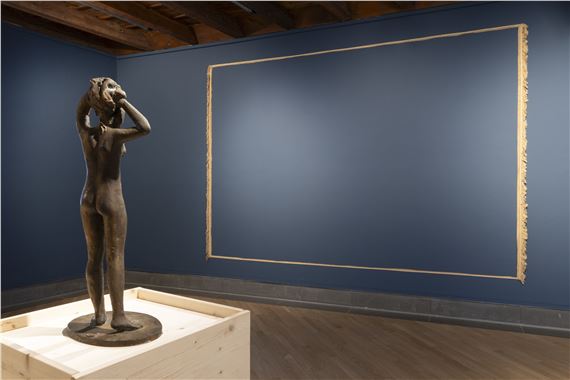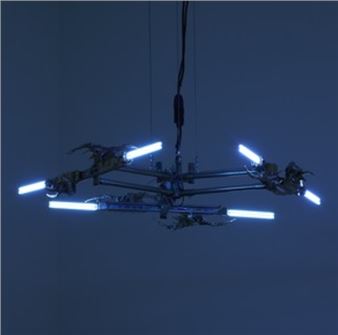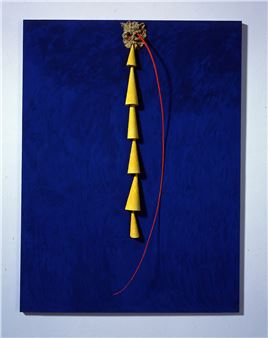Una Galleria: Tante Collezioni
From February 10, 2024, the GAMeC вҖ“ Galleria dвҖҷArte Moderna
e Contemporanea di Bergamo will present Una Galleria, Tante Collezioni: an
unprecedented display of its collections which aims to render all the richness
and eclecticism of the city through BergamoвҖҷs modern and contemporary artistic
heritage.
An exhibition conceived to remain on view in the rooms of
the Via San Tomaso venue for an extended time, in parallel with the Pensare
come una montagna (вҖңThink Like a MountainвҖқ) program, which over the next two
years will involve Bergamo and its territory in a range of widespread projects,
to be staged in collaboration with artists and local communities.
The new exhibition itinerary aims to accompany the public
toward the opening of the GalleryвҖҷs future venue, and presents the museum
collections from a perspective unlike that investigated in the cycle La
Collezione Impermanente (вҖңThe Impermanent CollectionвҖқ): the research,
exhibition and workshop platform with which from 2018 to 2023 GAMeC presented a
series of temporary exhibitions to stimulate reflection on the dynamic nature
of its collections.
In fact, Una Galleria, Tante Collezioni intends to bring out
the differences between the multiple fonds that make up the museum collections,
establishing a non-chronological dialogue between more than 150 works by
Italian and international masters of the twentieth century, also including
works by contemporary artists, along an exhibition path that winds its way
through the GalleryвҖҷs nine exhibition rooms.
These fonds intrinsically display a variety of languages,
styles, currents and perspectives that are often distant from one another,
while revealing traits of their origin: the tastes of collectors, their visions
on the past or the contemporary scene, the works of artists that have been
explored in temporary exhibitions, or even the initiatives promoting the work
of artists and curators carried out by the institution itself.
The identity and history of the GAMeCвҖҷs heritageвҖ”be it
donated to the city by private individuals and artists, or acquired by the
Gallery over the decadesвҖ”provide the focus of the exhibition, highlighting
works belonging to the largest number of fonds from the collections to be
exhibited to date, some of which are presented to the public here for the first
time.
The exhibition path, curated by Maurizio Bosa, translates
the dynamic idea of вҖңputting on showвҖқ what is to be found in the GalleryвҖҷs
storerooms into a both spatial and morphological metaphor. The structures, made
of deliberately untreated light-colored wood, consist of shelves on which the
works are placed, and of structures akin to open crates that provide novel
perspectives from which to observe the works on display.
The rooms house paintings by twentieth-century artists, part
of the Gianfranco and Luigia Spajani Collection; a selection of works by
Giacomo ManzГ№ and the Stucchi Collection, revolving around the 1950s and 1960s;
and a major fond dating back to the second half of the twentieth century,
confiscated in Lombardy and managed by the National Agency for the
Administration of Sequestered Property.
WhatвҖҷs more, a selection of donations from artists and
collectors of the new millennium, also including works that have become part of
the museumвҖҷs heritage thanks to major fonds and awards: the Premio Lorenzo
Bonaldi per lвҖҷArte вҖ“ EnterPrize, an international award that GAMeC has
dedicated to curators under thirty since 2003; the Meru Art*Science Award,
which for more than ten years has supported the research of artists
investigating the link between art and science; the Club GAMeC Prize, conceived
in 2016 by the association of Friends of the Gallery, acknowledging the work of
young Italian artists; and the fond named after collector Arturo Toffetti,
which has allowed for the creation of major solo shows dedicated to various
contemporary artists.
Also on display are works that have entered the collections
as part of the projects that the GAMeC has developed over recent years thanks
to the support of the Ministry of CultureвҖҷs General Directorate for
Contemporary Creativity, such as the Italian Council: the program for the
international promotion of Italian art, and the PAC вҖ“ Plan for Contemporary
Art, which allocates funding aimed at enhancing Italian public collections.
Completing the exhibition are a series of photographs from
the Lanfranco Colombo Collection, a number of medals and related models donated
by Vittorio Lorioli, and a selection of films from the Nino Zucchelli Archive.
Una Galleria, Tante Collezioni constitutes a valuable
opportunity to rethink the institution and further strengthen the roots that
bind GAMeC to its territory, while maintaining an active dialogue between the
museum and the community and continuing to work on the enhancement of the
cityвҖҷs heritage, especially in view of its upcoming move to a new location.

Recommended for you
From February 10, 2024, the GAMeC вҖ“ Galleria dвҖҷArte Moderna
e Contemporanea di Bergamo will present Una Galleria, Tante Collezioni: an
unprecedented display of its collections which aims to render all the richness
and eclecticism of the city through BergamoвҖҷs modern and contemporary artistic
heritage.
An exhibition conceived to remain on view in the rooms of
the Via San Tomaso venue for an extended time, in parallel with the Pensare
come una montagna (вҖңThink Like a MountainвҖқ) program, which over the next two
years will involve Bergamo and its territory in a range of widespread projects,
to be staged in collaboration with artists and local communities.
The new exhibition itinerary aims to accompany the public
toward the opening of the GalleryвҖҷs future venue, and presents the museum
collections from a perspective unlike that investigated in the cycle La
Collezione Impermanente (вҖңThe Impermanent CollectionвҖқ): the research,
exhibition and workshop platform with which from 2018 to 2023 GAMeC presented a
series of temporary exhibitions to stimulate reflection on the dynamic nature
of its collections.
In fact, Una Galleria, Tante Collezioni intends to bring out
the differences between the multiple fonds that make up the museum collections,
establishing a non-chronological dialogue between more than 150 works by
Italian and international masters of the twentieth century, also including
works by contemporary artists, along an exhibition path that winds its way
through the GalleryвҖҷs nine exhibition rooms.
These fonds intrinsically display a variety of languages,
styles, currents and perspectives that are often distant from one another,
while revealing traits of their origin: the tastes of collectors, their visions
on the past or the contemporary scene, the works of artists that have been
explored in temporary exhibitions, or even the initiatives promoting the work
of artists and curators carried out by the institution itself.
The identity and history of the GAMeCвҖҷs heritageвҖ”be it
donated to the city by private individuals and artists, or acquired by the
Gallery over the decadesвҖ”provide the focus of the exhibition, highlighting
works belonging to the largest number of fonds from the collections to be
exhibited to date, some of which are presented to the public here for the first
time.
The exhibition path, curated by Maurizio Bosa, translates
the dynamic idea of вҖңputting on showвҖқ what is to be found in the GalleryвҖҷs
storerooms into a both spatial and morphological metaphor. The structures, made
of deliberately untreated light-colored wood, consist of shelves on which the
works are placed, and of structures akin to open crates that provide novel
perspectives from which to observe the works on display.
The rooms house paintings by twentieth-century artists, part
of the Gianfranco and Luigia Spajani Collection; a selection of works by
Giacomo ManzГ№ and the Stucchi Collection, revolving around the 1950s and 1960s;
and a major fond dating back to the second half of the twentieth century,
confiscated in Lombardy and managed by the National Agency for the
Administration of Sequestered Property.
WhatвҖҷs more, a selection of donations from artists and
collectors of the new millennium, also including works that have become part of
the museumвҖҷs heritage thanks to major fonds and awards: the Premio Lorenzo
Bonaldi per lвҖҷArte вҖ“ EnterPrize, an international award that GAMeC has
dedicated to curators under thirty since 2003; the Meru Art*Science Award,
which for more than ten years has supported the research of artists
investigating the link between art and science; the Club GAMeC Prize, conceived
in 2016 by the association of Friends of the Gallery, acknowledging the work of
young Italian artists; and the fond named after collector Arturo Toffetti,
which has allowed for the creation of major solo shows dedicated to various
contemporary artists.
Also on display are works that have entered the collections
as part of the projects that the GAMeC has developed over recent years thanks
to the support of the Ministry of CultureвҖҷs General Directorate for
Contemporary Creativity, such as the Italian Council: the program for the
international promotion of Italian art, and the PAC вҖ“ Plan for Contemporary
Art, which allocates funding aimed at enhancing Italian public collections.
Completing the exhibition are a series of photographs from
the Lanfranco Colombo Collection, a number of medals and related models donated
by Vittorio Lorioli, and a selection of films from the Nino Zucchelli Archive.
Una Galleria, Tante Collezioni constitutes a valuable
opportunity to rethink the institution and further strengthen the roots that
bind GAMeC to its territory, while maintaining an active dialogue between the
museum and the community and continuing to work on the enhancement of the
cityвҖҷs heritage, especially in view of its upcoming move to a new location.
Artists on show
- Achille Emile-Othon Friesz
- Albert Marquet
- Alberto Burri
- Alberto Magnelli
- Alberto Savinio
- Alberto Vitali
- Aldo Tagliaferro
- Alessandro Biggio
- Alfredo Pirri
- Aligi Sassu
- Andy Warhol
- Anna Franceschini
- Antonio Rovaldi
- Arman
- Armin Linke
- Arnaldo Pomodoro
- Attilio Nani
- Attilio Steffanoni
- Auguste Rodin
- Auguste Sandoz
- Berlinde de Bruyckere
- Berthe Morisot
- BЕҷetislav Pojar
- Bruno Boari
- Bruno Cassinari
- Calisto Gritti
- Charles Chinet
- Chiara Bersani
- Christian Frosi
- Christo
- Claudio Sugliani
- Daiga Grantina
- Danilo De Marco
- Diego Marcon
- Dorothea Tanning
- Elio Mariani
- Emilio Scanavino
- Emilio Vedova
- Ennio Morlotti
- Enrico Baj
- Enrico Castellani
- Felice Casorati
- Ferdinando Scianna
- Filippo de Pisis
- Francesco Gennari
- Gabriele Basilico
- Getulio Alviani
- Giacomo Balla
- Giacomo Manzù
- Gianni Dova
- Gio Pomodoro
- Giorgio Boschetti
- Giorgio de Chirico
- Giorgio Morandi
- Giovanni Rubino
- Giuseppe Gabellone
- Giuseppe Leone
- Giuseppe Pessina
- Graham Sutherland
- Hans Hartung
- Hans Richter
- Iva Lulashi
- Jan Е vankmajer
- Jean Fautrier
- Jeremy Deller
- JiЕҷí Trnka
- Josh Tonsfeldt
- K.O.S.
- Latifa Echakhch
- Letizia Battaglia
- Lorenza Longhi
- Louis Marcoussis
- Lucia Pescador
- Luciana Mulas
- Luciano Fabro
- Lucio Fontana
- Luigi Rossi
- Luis Feito
- Marcello Maloberti
- Mario Cresci
- Mario Dondero
- Mario Giacomelli
- Mario Radice
- Mario Sironi
- Massimo Campigli
- Nino Lo Duca
- Ornaghi & Prestinari
- Oscar Giaconia
- Piero Brolis
- Piero Dorazio
- Piero Fornasetti
- Pietro Donzelli
- Regina Bracchi
- Roberto Crippa
- Roberto Fassone
- Roberto Matta
- Rochelle Goldberg
- Sarah Sparkes
- Stanley Vanderbeek
- Stefano Boccalini
- Stefano Locatelli
- Tancredi Parmeggiani
- Tim Rollins
- Tomas Saraceno
- Ugo Mulas
- Umberto Boccioni
- Umberto Milani
- Vatroslav Mimica
- Victor Pasmore
- Victor Vasarely
- Vincenzo Carrese
- Wassily Kandinsky
- Zoran MuЕЎiДҚ

 ARTISTS
ARTISTS















